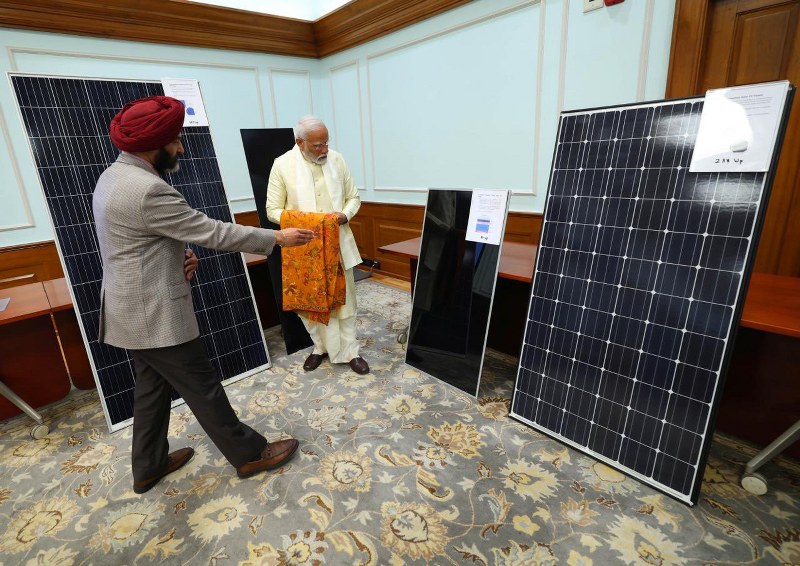
Pradhan Mantri Suryodaya Yojana: Know about the benefits and eligibility
Prime Minister Narendra Modi unveiled the 'Pradhan Mantri Suryodaya Yojana,' a programme aimed at offering rooftop solar panels to consumers.
The initiative, known as the Pradhanmantri Suryodaya Yojana, seeks to electrify households through solar rooftop installations, with an additional incentive for surplus electricity generation.
The Prime Minister also urged the launch of a nationwide campaign to encourage residential users to adopt rooftop solar on a large scale.
According to the Press Information Bureau (PIB) release dated January 22, 2024, “Immediately after his visit to Ayodhya on the auspicious occasion of consecration of Suryawanshi Bhagwan Shri Ram, Prime Minister chaired a meeting to launch ‘Pradhanmantri Suryodaya Yojana’ with the target of installing rooftop solar on 1 crore houses.
"During the meeting, the Prime Minister said that the power of the sun can be harnessed by every household with a roof to reduce their electricity bills and to make them truly aatmanirbhar for their electricity needs.”
PM Modi took to X (previously Twittter) to tell his followers about the solar rooftop scheme, emphasizing that this was the first big step he took after returning from Ayodhya.
सूर्यवंशी भगवान श्री राम के आलोक से विश्व के सभी भक्तगण सदैव ऊर्जा प्राप्त करते हैं।
— Narendra Modi (@narendramodi) January 22, 2024
आज अयोध्या में प्राण-प्रतिष्ठा के शुभ अवसर पर मेरा ये संकल्प और प्रशस्त हुआ कि भारतवासियों के घर की छत पर उनका अपना सोलर रूफ टॉप सिस्टम हो।
अयोध्या से लौटने के बाद मैंने पहला निर्णय लिया है कि… pic.twitter.com/GAzFYP1bjV
Who is eligible for the scheme
Through the Pradhan Mantri Suryodaya Yojana, 1 crore families will be given access to rooftop solar energy. This scheme is meant to help poor and middle-income households lower their electricity bills.
In 2014, the government launched the Rooftop Solar Programme with the aim of achieving a cumulative installed capacity of 40,000 megawatts (MW) or 40 gigawatts (GW) by 2022.
A watt, defined as a unit of power, represents the amount of energy consumed over time, specifically one Joule per second.
Here are some key FAQs about the advantages and utilization of the rooftop solar programme, as outlined on the government's website.
The advantages and usage benefits of the rooftop solar programme include:
Saving on Electricity Bill by the Consumer:
Consumers can realize cost savings on their electricity bills through the generation of solar power.
Utilization of Available Vacant Roof Space:
The program leverages existing vacant roof spaces, eliminating the need for additional land.
Low Gestation Period:
The implementation of rooftop solar has a relatively short gestation period, leading to quicker results.
No Additional Requirement of Transmission and Distribution (T&D) Lines:
The initiative does not necessitate the installation of extra transmission and distribution lines.
Reduction of T&D Losses:
Collocating power consumption and generation reduces transmission and distribution losses.
Improvement in Tail-end Grid Voltages and Reduction of System Congestion:
The program contributes to enhanced grid voltages at the tail end and reduces congestion in the system.
Long-term Energy and Ecological Security:
There is a long-term benefit in terms of energy security and ecological well-being due to a reduction in carbon emissions.
Better Management of Daytime Peak Loads by DISCOM/Utility:
Distribution Companies (DISCOMs) or utilities can effectively manage daytime peak loads through solar energy.
Meeting Renewable Purchase Obligations (RPOs) of Obligated Entities:
The rooftop solar programme aids obligated entities in meeting their Renewable Purchase Obligations.
This scenario is uncommon because consumers may still incur minimum charges, such as fixed charges, even if all consumed energy is self-generated.
However, by strategically designing and maintaining the Rooftop Solar (RTS) system, it is possible to reduce the 'electricity charges,' a significant component of the monthly bill, to zero. In states that provide revenue for surplus power generated, there is a potential for the monthly electricity bill to reach zero.
The prospective beneficiary has the option to install solar rooftop systems through project developers, system integrators, manufacturers, etc., following the requisite approval process from Distribution Companies (DISCOMs).
The installation capacity should align with the limits specified in the order issued by the respective State Electricity Regulatory Commission or Joint Electricity Regulatory Commission of the concerned States/Union Territories.
Support Our Journalism
We cannot do without you.. your contribution supports unbiased journalism
IBNS is not driven by any ism- not wokeism, not racism, not skewed secularism, not hyper right-wing or left liberal ideals, nor by any hardline religious beliefs or hyper nationalism. We want to serve you good old objective news, as they are. We do not judge or preach. We let people decide for themselves. We only try to present factual and well-sourced news.






